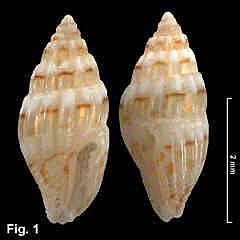|
|
|
|
|
Zafra troglodytes (Souverbie, 1866) Description: Shell solid, partly translucent, whorls turreted, aperture more than 1/3 total shell length. Axial sculpture of strong ribs, 14-16 on body whorl, usually fading out on the last third of body whorl. Spiral sculpture of a single cord below suture, weaker than axial ribs, forming nodule at intersections. Numerous spiral cords on base, sometimes extending to middle of body whorl. Outer lip sinuous in profile, slightly thickened externally; thickened internally along whole length, with 5-9 denticles. Columellar callus sharp edged, weakly dentate along outer edge; no deep groove at top deep inside aperture. Siphonal canal slightly upturned, notch moderately deep. Body whorl translucent, with bands of opaque white at top, midbody and base, although midbody and basal bands may be absent; spiral brown line consistently present below upper white band, and sparse wavy brown lines on base. Size: Up to 3.5 mm in length. Distribution: Indo-West Pacific; in eastern Australia, as far south as Sydney. Habitat: Most specimens sorted from beach shell grit. Common in the tropics, rare in NSW. Comparison: Z. troglodytes is consistently the most globose of all the Zafra species, and the whorls most convex. Its colour pattern is distinctive. Synonymy: Columbella succinea Hervier, 1900 is a synonym. Fig. 1: Clarence River, NSW (C.304461) |
